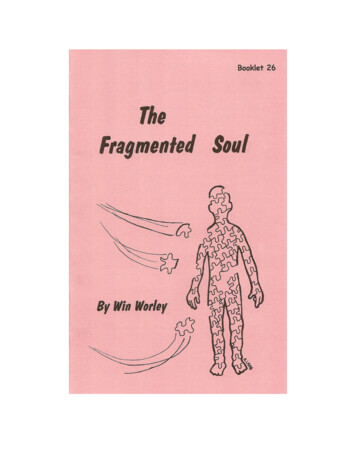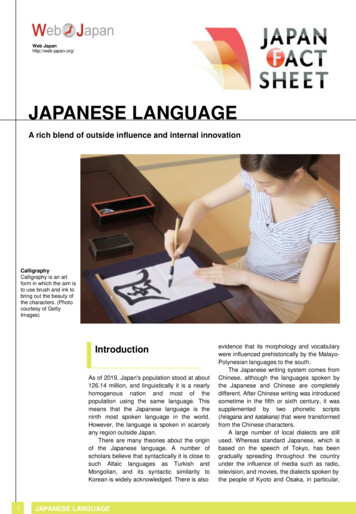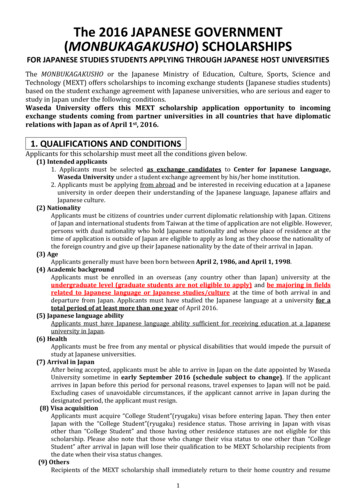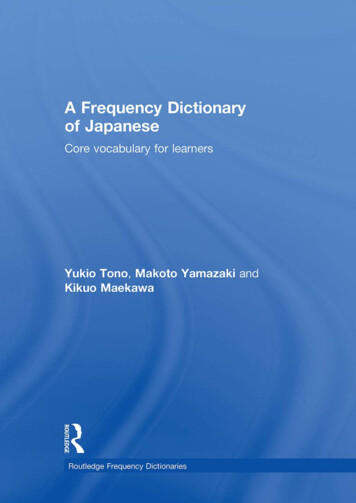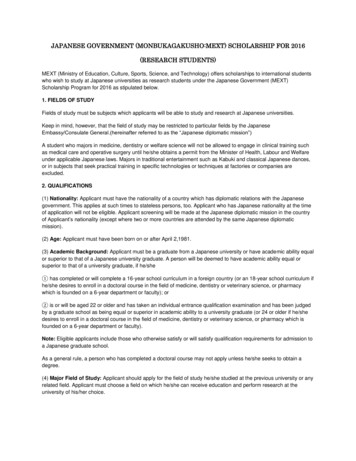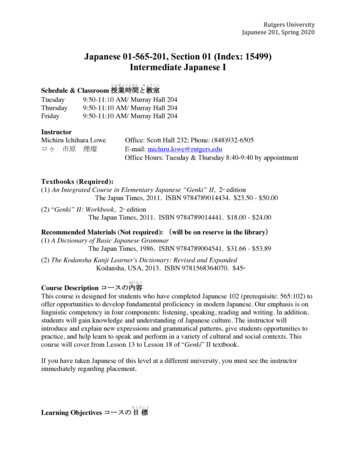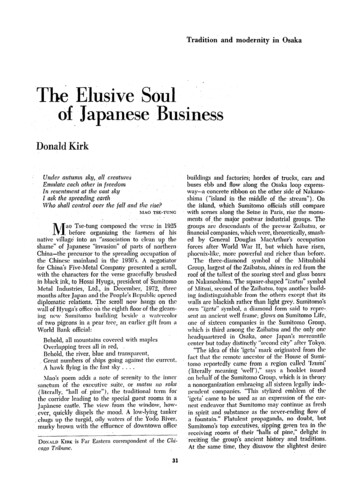
Transcription
Tradition and modernity in OsakaThe Elusive Soulof Japanese BusinessDonald KirkUnder airtiinin sk!yrl,all creatiiresEmulate each other in freedomIn iasentnient at the ljast sky1 ask the spreading earthWho shall control over the fall and tlie rise?XLAO TSE-TUNCNIao Tse-tung composed tlie verse in 1925before orgill1izing the farincrs of hisnative village into an “association to clean up theshame” of Japanese “invasion” of parts of northernChina-the precursor to tlie spreading occupation ofthe Chinese mainland in the 1930’s. A llegotiiltorfor China’s Five-Metal Company presented a scroll,with the characters for the verse grncefully brushedin black ink, to Hosai Hyuga, president of SumitomoMetal Industries, Ltd., in December, 1979, threemonths after Japan and the People’s Rel iil licopeneddiplomatic relations. The scroll now hangs on tlicwall of Hyuga’s office oh the eighth floor of the gleamiiig n c w Snmilonio I)uiltling l)c sitl( ;I \v;it(.rcolorof two pigeons in a pear tree, an carliw gift from i1World Rank official:Behold, all mountains covered with maplesOverlapping trees all in red,Behold, the river, blue and transparent,Great numbers of ships going against the current,A hawk flying in the fast sky . . . .llao’s poem adds a note of serenity to the innersnnctum of the executive suite, or nmfstr 110 t o k i(literally, “hall of pine”), the tridtionid term fol.the corridor leading to the special guest rooms in aJapBnese castle. The view from the window, however, quickly dispels the mood. A l o d y i n g tankerchugs up the turgid, oily waters of the Yodo River,murky brown with the effluence of downtown officeDOS.-\LDKIRK is Fiir Ei1stern correspondent of thecngochi-Tribune.31buildings and factories; hordes of trucks, cars andbuses ebb and flow along the Osaka loop expressway-a concrete ribbon on the other side of Nilkillloshima (“island in the middle of the streiim”). Onthe island, which Sumitomo officials still comparewith scenes along the Seine in Paris, rise the monuments of. the major postwar industrial groups. Thegroups are descendants of the pren’ar Zi1ibi1tsu, orfinnnciiil companies, wbich were, theoretically, smashed by General Douglas X lacArthur’s occupationforces after World War 11, but which have risen,phoenis-likc, more powcrful ilnd richer thiln before.The three-diamond symbol of the hlitsubishiGroup, largest of the Zaibatsu, shines in red from theroof of the tallest of the soaring steel and glass boseson Nakanoshima. The square-shaped “i;irtstr” symbolof Mitsui, second of the Zaibatsu, tops anotlicr builcling indistinguishnble from the others except that itswalls are blackish rather than light grey. Sumitomo’sown ‘‘igcta” symbol, a d i a m o d form said to represent an ancient well frame, g l o 011 Suniitonio Life,one of sisteen companies in the Sumitomo Group,n liichis third among the Zilibatsu a l dthe 0111 7 OWhcadquartered in Osaka, once Japan’s mcrcantilccenter but today clistinctly “second city” nftcr Tokyo.“The idea of this ‘igeta’ lnilrk originated from thefact that the remote ancestor of the House of Sumitomo r e p o r t d y came froin il region called ‘Izumi’(literally meaning ‘well’),” says a booklet issuedon 1)rIialf of the Sumitomo Group, \vhich is in theorya nonorganization embracing ill1 sixteen lcgally inde1xwIcnt companies. “This stylized cmblcni of thc‘igctii’ came to be usecl as an cspression of the earnest endeavor that Sumitomo may continue as freshin spirit and substance as the never-ending flow ofn fountain.” Flatulent propaganda, no doubt, butSumitomo’s top executives, sipping green tea in thcreceiving rooms of their “hnlls of pine,” delight inreciting the group’s ancient history and traditions.At the same time, they disavow the slightest desire
32WORLDVIEWIFEBRUARY 1974to revert to the heyday of the “Sumitomo Honsha,”the vast holding company that made decisions forthe entire group before its dissolution at the end ofthe war. “Fundamentally we have the same policyas before,” says Hosai Hyuga, wartime chief of planning for Sumitomo Metal, which produced sheetmetal for the Zero fighters assembled by Mitsubishi.“There is not a big difference in management philosophy either,” adds Hyuga, whose principal wartime concern was scattering plants around.the countryside in order to escape American bombing. “Butbefore the war,” he continues, “the group was controlled by the Sumitomo family. They o w e d thestock and decided on personnel. Now other companies in the group own 20 per cent of our stock,and the rest is held by outside stockholders. TheSumitomo family kept very little. The company isfor the Sumitomo management and for the peoplewho own stock. But the philosophy is the same.”Hyuga, in dark-grey suit and white shirt, fits theimage of the Japanese corporate leader, just as hundreds of younger Sumitomo men in lesser positionsmerge with the mass of organization types quietlyworking in the headquarters here and in the salesoffice in Tokyo. A smallish man with steel-gray hairand owlish eyes, he speaks with soft intensify. Hesmiles only when reminiscing about the first momcmts o panic after the war. He and his colleaguesdo not disguise their amusement at what they regard:IS the bumbling stupidity of their conquerors.“On the day of the surrender I bumecl all mypapers,” he says, with just a touch of nostalgia. “13ut .the ‘authorities’ did not bother with such a small‘scction chief’ as me. They were thinking of how to‘normalize’ the whole country. So now I think it wasrather ridiculous to burn my papers.” Hyuga-andSumitomo hletal-outfoxed the, Americans four yearslater, in 1949, when they had to close their “oIcYcompany and reestablish a ‘‘new” Sumitomo Metal,modeled on lines dictated by the Americans. “Temporarily we had a different name,” says Hyliga, whohas-or feigns-difficulty recalling just what they didcall the reorganized company. Ah yes, Fuso Metals,he thinks ( Fuso means the .Land of the Rising Sun).“Rut we changed the name back to Sumitomo in1959, as soon as the occupation was over.”It was the same story for all the big coinpanics-the terror, the rebirth, the recovery. “When the war ended, the problem was howto live,” says Horishige Hasegawa, a .1931 classmateof H yuga’s at Tokyo University, spawning groundof the Japanese political and commercial dlite, andnow president of Sumitomo Chemical. “In the late1940’s all we were producing was fertilizer and saccharin.” Hasegawa is not quite the “typical” Japancsc husincss executive. He sometimes wears lightcord suits and modestly colored or striped shirtsin contrast to the regulation white of his underlings.He is also a CathoIic convert, the only Catholicamong the first echelon of Sumitomo, and lives ina Westem-style home in the port city of Kobe. Inaddition, he is an art collector, student of Greekantiquities, and music lover. He has his own storyto tell of personal victory over the American occupation,“During the American bombing, my house was hit.I tried to put out the fire and fled with a painting,which I loved best, and a book,” says Hasegawa,smiling at the memory. “When the American armycame, they took over my house, so I had no placeto live. Then they confiscated my next house tooand said I shouldn’t remove the contents, includingmy piano. I asked an American officer for specialpermission, explaining that my wife was a musicianand could not live without the piano, and that Ialso had to teach my daughter the piano. It was a11untrue, but it worked,” he concludes, grinning triumphantly. After negotiating seven days, the Americans let him keep the piano.While the experience probably did not incrcilscHasegawa’s respect for the Americans, there is nobitterness in his teIling of the story. In fact, lie seemspersonnlly closer to Americans now than do mostSumitomo officials. He often visits the United States,is fond of American food and customs and rcadsavidly American books and magazines. “I am a greatlover of Damon Runyon,” he says; “Unfortunatelyvery little of his work is translated into Japancse.”How did the president of Sumitomo Chemical become a Damon Runyon. fan? “I saw the musicalGtiys and DolIs in New York years ago. It has pathos-the characters are wicked, but they have heart.”Hasegawa views Japan and the United States asinseparable” and fervently hopes they will be “evciimore prosperous as a result of better business relationships.” One suspects this is more than goodpublic! relations. Just as Sumitomo, and Japan,adopted a ruthlessly narrow attitude toward foreigncompetition, notably American, in the era of recovery, so Sumitomo and Japan can afford to relaxsomewhat now that they need no longer fear theprospect of succumbing to an invasion of Americaninvestment and imports. As the trade imbalance between the two countries climbed to absurd heights( 4 billion in 1972), American diplomats waged anegotiating offensive, Peplete with threats of sancU.
THE SOUL OF JAPANESE BUStNESStions, quotas and high tariffs, to reverse the trend.The imbalance is expected to fall to 2 billion thisyear, and Japanese businessmen seem almost proudas they recite steadily declining export figures. Thereversal in the soaring deficit parallels a reversal inoutlook from new confidence as much as from diplomatic intimidation.“I was one of the strongest proponents of liberalization,” Hasegawa notes proudly. “Sometimes I hadto go between Japan and the United States to explain their problems one to the other. Japan is anisland country, so the people lack internationalknowledge or sense. When we think about the future,we must open the doors ourselves. We must be positive. I personally am not at all afraid of competition.”Hasegawa, a stocky figure with piercing thin eyes,can afford to exude confidence. The largest chemicalmanufacturer in Japan, Sumitomo ranks 111th onFortuiic’s 1972 list of “the 300 largest companies outside the US”-up from 124th the year before. Sumitomo Metal, the largest of the group, is even moresuccessful-47th on the Fortune list, up five fromI?st ‘year, with 1972 sales over 2 billion and profitsnearly 25 million. Sumitomo Bank, perhaps the mostinfluential Sumitomo entity, comes in third on Fortrciio’s listing of the “fifty largest commercial bankingcompanies outside the US,”with assets of more than 22 billion at the end of last year-an increase of46.45 per cent over 1971, partly due to dollar devaluation.Wealthy beyond the wildest dreams of its oncefrightened leaders, the group can now indulge insome of the patronizing associated with such greatAmerican corporate names as Ford and Rockefeller.“The traditional philosophy of the old Sumitomogroup,” says Koji Asai, who retired last May as president of the bank, “was that all profits should be returned to the community. That philosophy prevailedin the prewar days, and the leaders of Sumitomofeel they have just recovered from the setback of thewar.” It was, as Asai describes it, almost coillcidentidthat the first beneficiaries of Sumitomo’s revivedphilosophy were Yale University and the Japitn Society in New York. “I and the other presidents hadin mind that Japanese recovery was due to Americanaid after our surrender,” says Asai, sounding morelike an American businessman rationalizing the success story of a Japanese competitor than the calculating Japanese banker he is. “Then it happened thatthe Yale people came up with their request.”Actually, the decision to donate‘ 2 millionto Yale and 1million to the Japan Society for furthering Japanese studies resulted fromcomplex circumstances and personal relationshipsfinally culminating in unanimous approval by thepresidents of all sixteen Sumitomo companies. In thecase of the Yale donation, Kensuke ltrotta, assistantto the head of the international division of Sumitomo/ . 33Bank and son of bank chairman Shozo Hotta, wasa key, although unpublicized, figure. The youngerHotta, a debonair graduate of Toliyo’s Keio University, a prestigious private institution with a playboyish reputation, talked with a Yale alumnus andencouraged him to get in touch with his father.Finally, members of the Yale faculty met personallywith Asai and the elder Hotta, lamenting that Yalemight have to scale down Japanese studies drastically unless a large grant was forthcoming. Wliyshouldn’t an enormous Japanese group, such asSumitomo, contribute to “understanding Japan” byfinancing the Yale endeavor? The idea seemed particularly sensible at a time when Japanese and American diplomats and businessmen were quarrelingbitterly over tariffs and quotas.Not the least abstruse aspect of the maneuver wasthe remarkable ease with which the sixteen Sumitom0 presidents routinely and without argument endorsed the gift at the monthly meeting in May. “Iseriously conceived of the idea of contributing insuch a manner when I became president ten yearsago,” confesses Asai, “but many other director thought the bank‘s earning capability was not enough.Only in the past four years have my colleagues considered changing their attitude to adjust to our newprosperity. The case of the contribution to l’alc isjust a small example of what we might do.” Howsuch decisions get made in fact touches upon the indefinable spirit that binds the Sumitomo Group and.by extension, Japanese business and society.Formally, the only. real instrument uniting thesixteen independent Sumitomo companies today is“Hakusuikai,” the council of presidents. The Haknsuikai meets for two or three hours each month, hereor in Tokyo. Sometimes the presidents appoint subcommittees of experts to study mutual problems,such as pollution, but more often than not they POlitely and quickly dispose of the business at handamong themselves before retiring for lunch. It is, infact, more an klite club of elders than a conventionaladministrative unit. Nor is the Hakusuikai particularly steeped in Sumitomo tradition. It was foundedafter the postwar reorganization of Sumitomo andthe dissolution of the old Sumitomo Honsha. “Wethought we should get to kn
of the Japanese political and commercial dlite, and now president of Sumitomo Chemical. “In the late 1940’s all we were producing was fertilizer and sac- charin.” Hasegawa is not quite the “typical” Japa- ncsc husincss executive. He sometimes wears light cord suits and modestly colored or striped shirts- in contrast to the regulation white of his underlings. He is also a CathoIic .
